The Cougar Attack X3 Mechanical Keyboard & 450M Gaming Mouse Review
by E. Fylladitakis on April 4, 2016 8:00 AM ESTCougar UIX System Software
The UIX System is the software that accompanies all of Cougar's advanced gaming peripherals. It allows the control of multiple devices from the same interface, as well as the transfer of commands from one device to another. However, in order for the software to function with each device, the software package of this particular device needs to be downloaded and installed.
In terms of simplicity, the UIX System interface is fairly user friendly and straightforward. Once you install the software package for the device(s) that you own, the software automatically recognizes the hardware and will immediately check for software/firmware updates. The user should be careful at that point, as the software does not ask for confirmation once a new firmware has been found - it will immediately proceed with the updating process and forcefully stopping it can permanently damage the device.
For any Cougar device that is connected, the UIX System has three main sections: performance, key assignment and lighting control. There is also a Game Profile Management section, which allows the user to save multiple profiles. Each profile has up to three modes, allowing on-the-fly setting changes via the keyboard's mode switch keys or other programmed keys. Each mode may have entirely different performance, key and lighting settings.
For the Attack X3 keyboard, the performance section allows the user to control the polling rate, the key rollover and the repeat delay. The polling rate and key rollover settings are pretty much self-explanatory; you will want these at the best possible settings (1000 Hz, N-Key Rollover), unless there are compatibility issues with your system. Cougar's repeat delay tuning options allow the user to control how quickly an actuated key will start repeating itself. There is a small test box for the user to check the settings.
As for the 450M mouse, the performance section is focused on DPI and speed settings. There is an option to adjust the polling rate but, once again, the user should leave that at maximum unless there are compatibility issues. Up to three DPI settings can be programmed in each mode of the 450M, as well as a "Sniper" mode that is active only if a corresponding hotkey is programmed to a button and that button is being held pressed. The software allows for the separate programming of the X and Y axes, which can lead to very advanced (and complicated) sensitivity options. It is also possible to adjust the lift height, as well as the double click, scroll and pointer speeds. The scrolling can also be set to "one screen at the time", which may be quite useful for professional use. A small box enables the hardware acceleration of the mouse. This does not affect the software acceleration of the OS, which needs to be disabled manually.
The lighting control of the Attack X3 keyboard is very simple. This particular model is stuck with single color backlighting and lacks the per-key lighting programming options of the more advanced 700K as well. The only setting is to program the number of steps that are accessible via the FN+F4 key combination, with the only options being three brightness settings, an "off" option and a simple "breathing" effect.
Meanwhile the lighting control section of the 450M is also simple, but still much more advanced than that of the Attack X3 keyboard. To being with, the user has access to RGB lighting. It is possible to adjust the illumination color to virtually millions of combinations, but the human eye cannot possibly discern the difference between more than a handful of colors. Cougar provides a color strip and ten preset color settings for convenience. The lighting can also be set at maximum intensity, which is not very strong to begin with, to a cycling or to a breathing effect. It is possible to link the lighting color of the DPI button to the current DPI setting, allowing the RGB LED to serve as an indicator. This option is limited to the DPI button and the logo's illumination setting remains unaffected by the DPI setting.
The key assignment section is very similar for both devices and, as the name suggests, the section where the user can change the settings of every key on the keyboard or the mouse. When the setting of any key has been changed from its default action, it will turn yellow on the pictured key map. The user can select from standard single keystroke actions, advanced options or programmed macros. The advanced options include mode switch keys, media functions and program launch commands. It is interesting that mouse-related functions can be programmed on the keyboard as well, as for example DPI switch settings and the "Sniper" mode that decreases the DPI setting of the mouse while the key is being held actuated. This can result to interesting gaming setups, allowing better control of mouse options from the keyboard. For example, for FPS gaming, the Sniper mode can be programmed on the right half of the Spacebar key, allowing faster and more convenient use of this option.
The built-in macro recorder is relatively simple but very functional. It allows the programming of macros that may or may not include mouse movements (in either absolute or relative coordinates too) and with natural, preset or no delay times between actions. Once the macro has been recorded, delay times and mouse coordinates can be manually edited by double-clicking on them. The macros can be set to play once, repeat a number of times, or repeat continuously until the button has been pressed again. The macro recorder lacks only two things - the option to return the mouse pointer at its original position after the execution of the macro has been completed and the capability to start/stop recording via a hotkey.


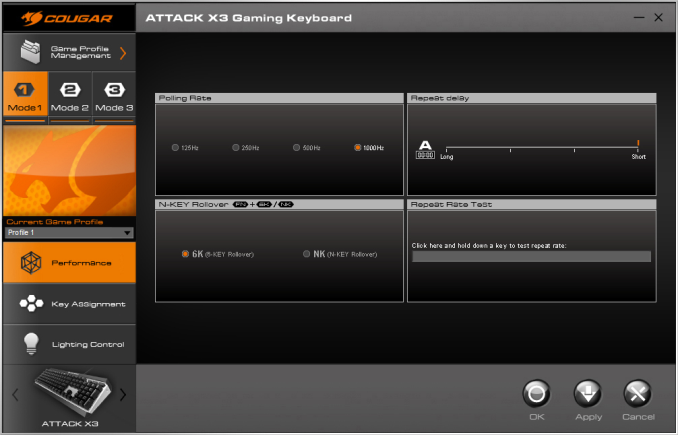

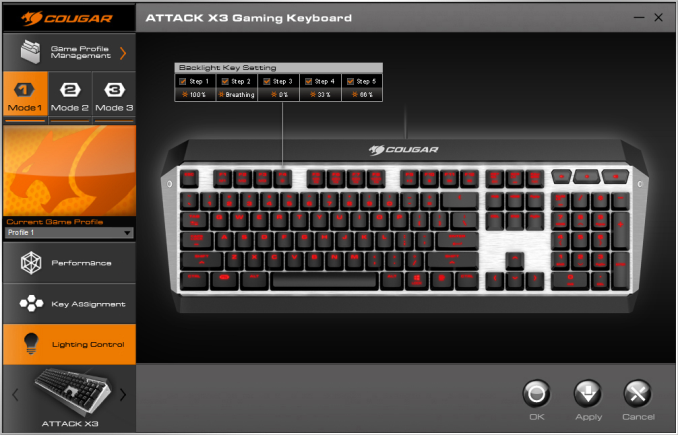

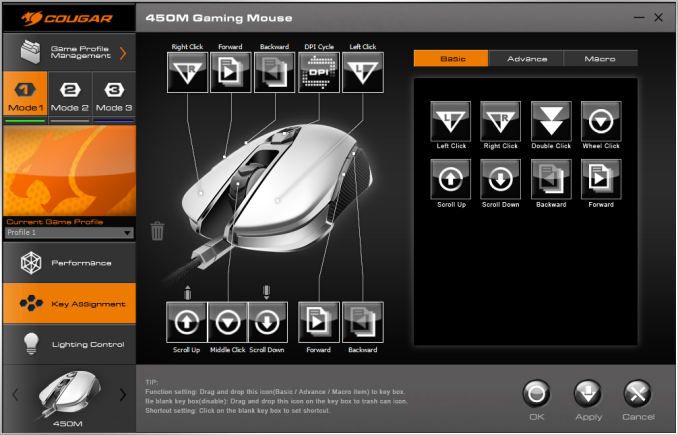
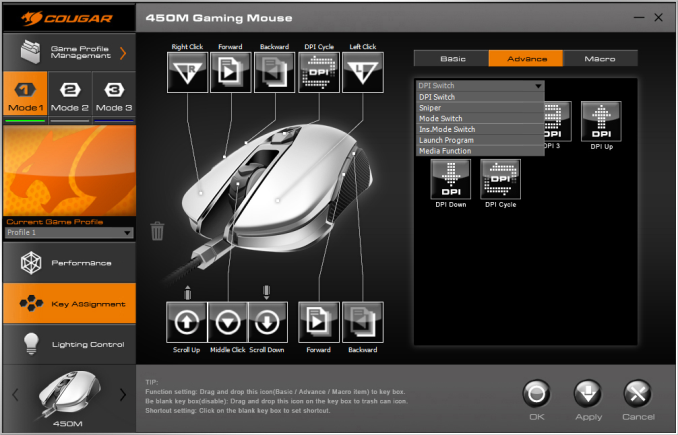

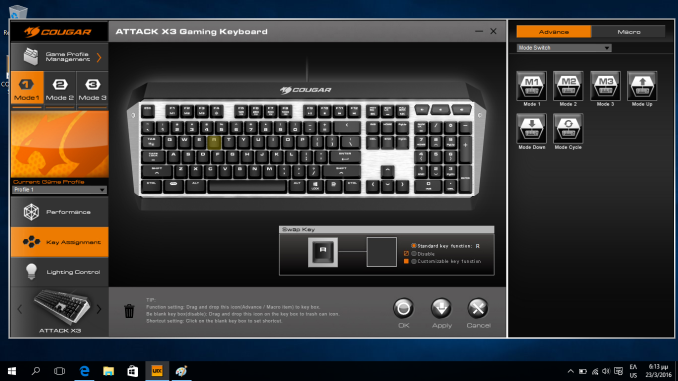
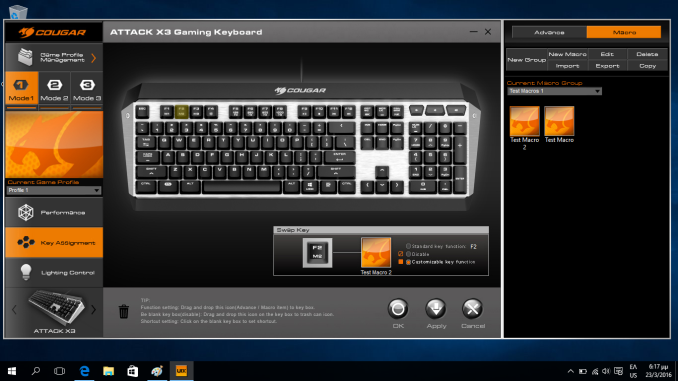
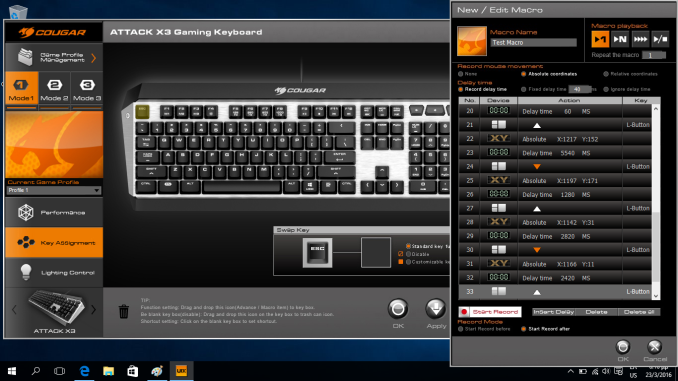








17 Comments
View All Comments
boskone - Monday, April 4, 2016 - link
I do on occasion, despite being right-handed. When I'm on the phone sometimes it's handy to be able to write and use the mouse at the same time.MrSpadge - Friday, October 21, 2016 - link
I do. I switch to the rght hand for (seldom) FPS gaming, though. In all other games it can stay left.cosmotic - Monday, April 4, 2016 - link
I love that you guys are using testing equipment to test the switches! It's too bad the developers of the software for this thing made such a mess.LordConrad - Tuesday, April 5, 2016 - link
I'll stick with my Unicomp Classic keyboard, buckle spring keyboards are the best.Mikuni - Thursday, April 7, 2016 - link
What's the point of a polling rate setting rather than being always at max?smartbubble - Friday, April 22, 2016 - link
Thank you for this review! In my opinion such keyboard will be a good purchase. I will buy it for sure soon. Of course when it occur I will share my opinion toosilverblue - Sunday, June 12, 2016 - link
$83 from Amazon US, £102 from Amazon UK for the MX Brown switches... but I can find it for £81 for the same model, again with MX Brown switches, from Kikatek. If I ever get bored of my generic keyboard, it could be an option. The 450M is about £30 from the same site, and its code name suggests it should be paired with the 450K keyboard which has a mechanical feel and is splash-proof. They appear to have a keyboard-mouse combination through their range, from the 500 to 600 and 700.